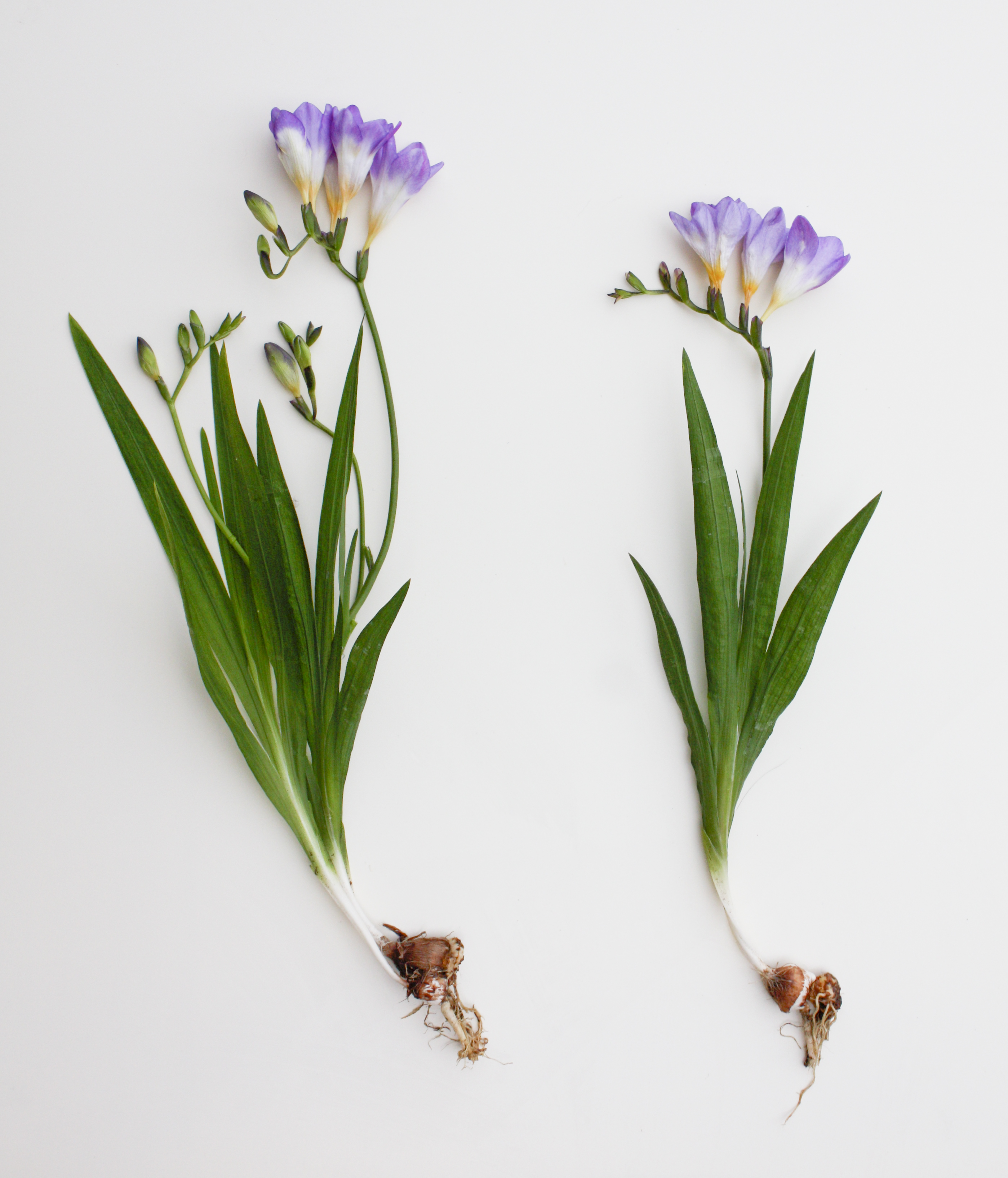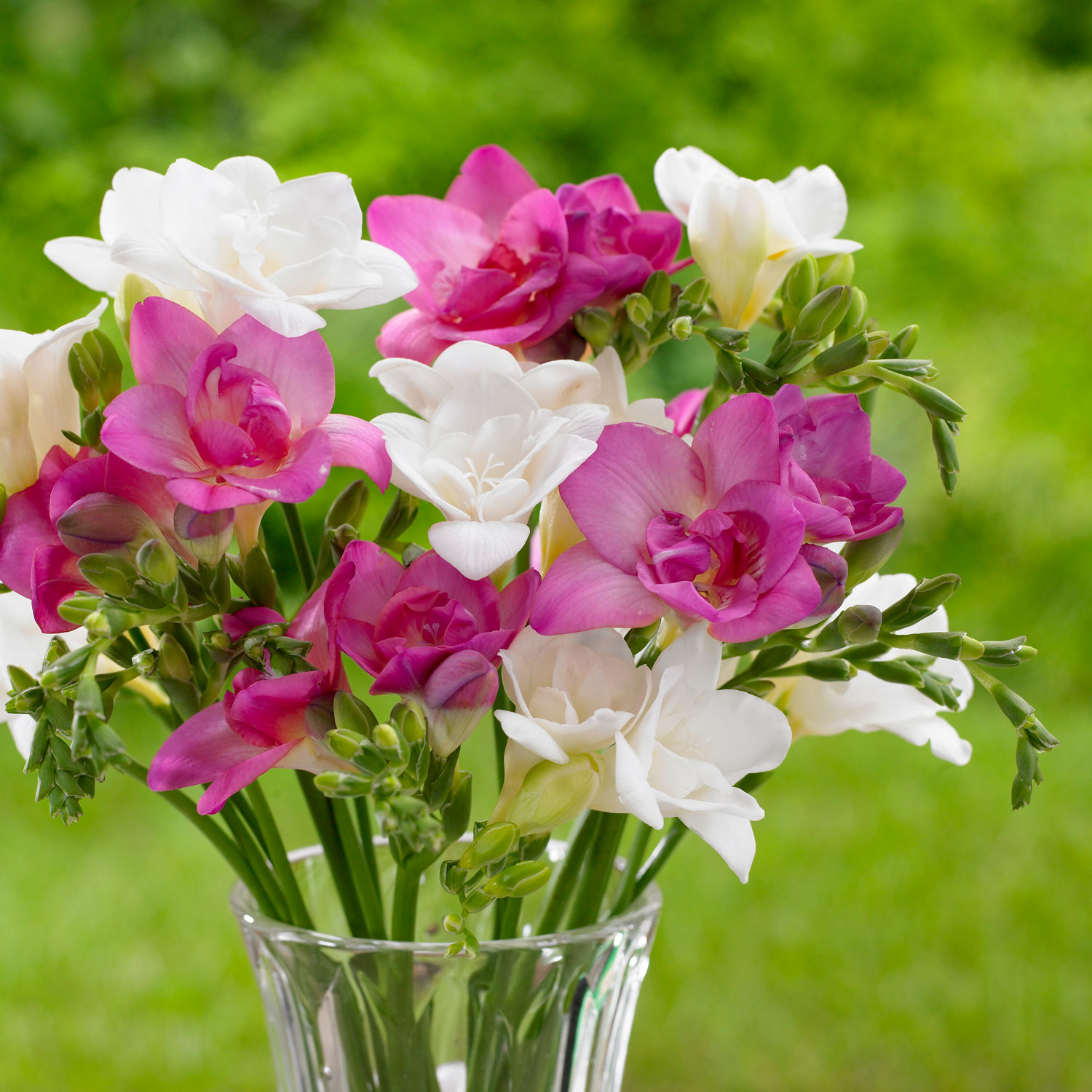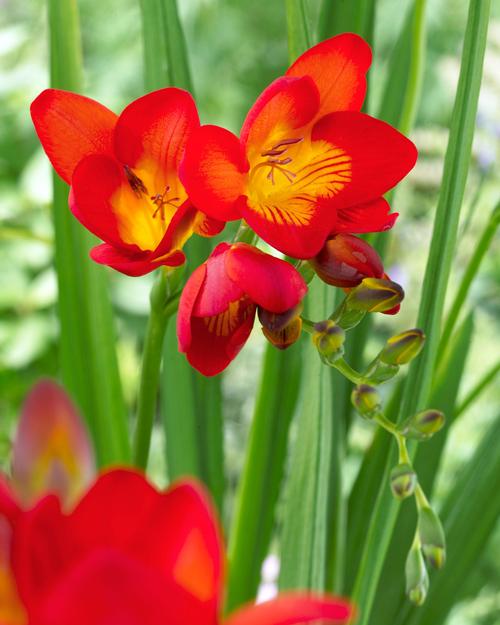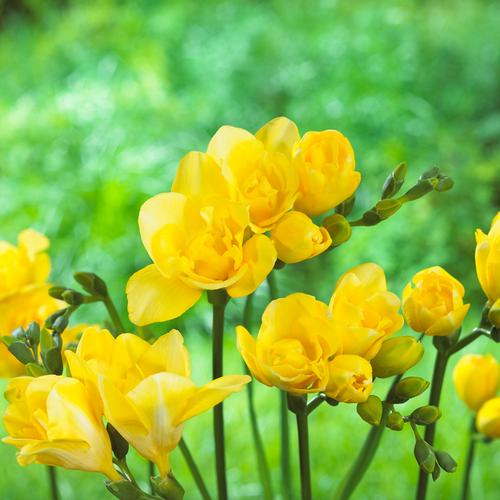ALL ABOUT FREESIA
Freesias are one of the world’s most popular cut flowers. They are loved for their pure colors, long vase life and sweet perfume. The corms may be grown in a garden or in containers for spring or summer blooms.
Each of the graceful 12”-15” stems bears six to twelve trumpet-shaped blossoms. The flowers may be single or double and are available in many beautiful colors including white, cream, yellow, orange, red, pink, mauve, lavender and purple. Freesias will fill a room with their sweet, baby powder fragrance.

START WITH A BETTER BULB
It’s easy to see the difference in quality when you compare two freesia corms side by side. Larger corms (as shown at far left) contain more stored energy and will give you more stems and more blooms.
To see our selection of freesia bulbs, click HERE.

PLAN FOR SUCCESS
Sun and Heat: Freesias may be grown in full sun or part shade. They grow best in cool, springtime temperatures (55 to 60°F), and may not bloom if temperatures rise over 70°F. If you are growing freesias in a greenhouse, keep the pots out of direct sunlight until they have sprouted. Then keep the plants as cool as possible until after they finish blooming.
Cold Hardiness: Freesias are winter hardy in growing zones 9-10. In zones 3-8 the corms will not survive the winter outdoors, but they can be grown as annuals (see below). To find your growing zone, reference the USDA Hardiness zone map HERE.
Soil and Moisture: After planting the corms, water sparingly until they sprout. Then water consistently, keeping the soil lightly moist. When the young plants are about 6” tall, begin fertilizing every 2 weeks with a liquid fertilizer.

WHEN AND WHERE TO PLANT FREESIA
In areas where freesias are winter hardy (zones 9-10) they should be planted outdoors in fall. Choose a sunny location with well-drained, fertile soil that contains plenty of organic matter. Plant the corms pointed end up, 1” to 2” deep and 2” to 3” apart. Over time they will multiply.
In cooler zones, freesias can be planted outdoors in spring for late summer flowers. The bulbs may also be planted in pots in the fall and grown in a cool (55-60°F) greenhouse for winter flowers.
When planting freesia in containers, choose relatively tall pots as freesias have a long tap root. Use a compost-enriched growing mix and consider adding some coarse sand or finely crushed stone to ensure excellent drainage. In a 5” pot, plant 6-8 corms 1” deep with the pointed end up. If using a larger pot, keep the bulbs about 1” to 2” apart.

TIPS FOR GROWING FREESIA
Knowing how a plant grows in its natural habitat can help you understand what it needs to thrive. Freesias are native to South Africa. Their natural growing season begins in late fall when the weather cools and the rainy season begins. The bulbs sprout in fall, produce foliage in the winter months and then bloom from late winter to early spring. After flowering, the freesia’s foliage gradually withers. The corms are dormant during the summer months when the weather is dry and hot.
Newly harvested freesia corms are given a special heat treatment that mimics their normal summer dormancy period. Even with this treatment, newly-planted corms can be slow to break out of dormancy and it may take a month or more for them to begin growing. The average time from planting to flowering is 110 to 120 days.
For a generous display of flowers, plant freesia corms in groups of 6 to 10, positioned no more than 2” apart. Plant single colors together or mix them for a rainbow effect.
Like gladiolas, freesias usually need support to keep their stems upright. Circular supports that surround the stems are ideal. Another option is to use slender bamboo canes or small branches and then tie the stems in with twine.

CARING FOR FREESIA IN ZONES 9-10
As the flowers fade, cut the stems (not the foliage) back to about 1”. Allow the foliage to keep growing until it yellows and then cut it very short. The corms can be left right in the ground. If you expect the soil to be moist during the summer, dig up the corms and store them somewhere dry and warm.
CARING FOR FREESIA IN ZONES 3-8
Gardeners in zones 3-8 usually treat freesias as annuals and purchase fresh bulbs each spring. To save the corms for next year, here's what to do.
If your freesias are planted in the ground, cut off the stems after the flowers fade and allow the plants to continue growing until the foliage yellows. Before the first frost, cut off any remaining foliage and dig up the corms. Let them dry in a protected place where they will not freeze. When the corms are completely dry, pull away any remaining debris. Store the corms in sand or peat moss, in a dry, dark, cool (55°F) place until it’s time to replant.
If your freesias are in pots, cut back the stems after flowering and keep the soil moist until the foliage begins to yellow. At that point, stop watering and move the pot to a sheltered location where it won’t get wet. Once the soil is completely dry, cut off the foliage and remove the corms. Pull away any old debris and store the new corms in sand or peat moss at 55°F.
To learn more, read: Cut Flower Favorites: Freesia and Ranunculus.
